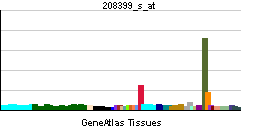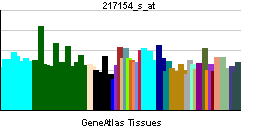Endothelin 3
| Endothelin 3 | |||||||||||
|---|---|---|---|---|---|---|---|---|---|---|---|
| Identifiers | |||||||||||
| Symbols | EDN3 ; ET3; MGC15067; MGC61498 | ||||||||||
| External IDs | Template:OMIM5 Template:MGI HomoloGene: 88 | ||||||||||
| |||||||||||
| RNA expression pattern | |||||||||||
 | |||||||||||
 | |||||||||||
| More reference expression data | |||||||||||
| Orthologs | |||||||||||
| Template:GNF Ortholog box | |||||||||||
| Species | Human | Mouse | |||||||||
| Entrez | n/a | n/a | |||||||||
| Ensembl | n/a | n/a | |||||||||
| UniProt | n/a | n/a | |||||||||
| RefSeq (mRNA) | n/a | n/a | |||||||||
| RefSeq (protein) | n/a | n/a | |||||||||
| Location (UCSC) | n/a | n/a | |||||||||
| PubMed search | n/a | n/a | |||||||||
Endothelin 3, also known as EDN3, is a human gene.[1]
The protein encoded by this gene is a member of the endothelin family. Endothelins are endothelium-derived vasoactive peptides involved in a variety of biological functions. The active form of this protein is a 21 amino acid peptide processed from the precursor protein. The active peptide is a ligand for endothelin receptor type B (EDNRB). The interaction of this endothelin with EDNRB is essential for development of neural crest-derived cell lineages, such as melanocytes and enteric neurons. Mutations in this gene and EDNRB have been associated with Hirschsprung disease (HSCR) and Waardenburg syndrome (WS), which are congenital disorders involving neural crest-derived cells. Four alternatively spliced transcript variants encoding three distinct isoforms have been observed.[1]
References
Further reading
- Calderone RA (1994). "Molecular interactions at the interface of Candida albicans and host cells". Arch. Med. Res. 24 (3): 275–9. PMID 8298278.
- Hofstra RM, Osinga J, Buys CH (1998). "Mutations in Hirschsprung disease: when does a mutation contribute to the phenotype". Eur. J. Hum. Genet. 5 (4): 180–5. PMID 9359036.
- Parisi MA, Kapur RP (2001). "Genetics of Hirschsprung disease". Curr. Opin. Pediatr. 12 (6): 610–7. PMID 11106284.
- O'Reilly G, Charnock-Jones DS, Davenport AP; et al. (1993). "Presence of messenger ribonucleic acid for endothelin-1, endothelin-2, and endothelin-3 in human endometrium and a change in the ratio of ETA and ETB receptor subtype across the menstrual cycle". J. Clin. Endocrinol. Metab. 75 (6): 1545–9. PMID 1464662.
- Mills RG, O'Donoghue SI, Smith R, King GF (1992). "Solution structure of endothelin-3 determined using NMR spectroscopy". Biochemistry. 31 (24): 5640–5. PMID 1610811.
- Rao VV, Löffler C, Hansmann I (1991). "The gene for the novel vasoactive peptide endothelin 3 (EDN3) is localized to human chromosome 20q13.2-qter". Genomics. 10 (3): 840–1. PMID 1889823.
- Arinami T, Ishikawa M, Inoue A; et al. (1991). "Chromosomal assignments of the human endothelin family genes: the endothelin-1 gene (EDN1) to 6p23-p24, the endothelin-2 gene (EDN2) to 1p34, and the endothelin-3 gene (EDN3) to 20q13.2-q13.3". Am. J. Hum. Genet. 48 (5): 990–6. PMID 2018043.
- Onda H, Ohkubo S, Ogi K; et al. (1990). "One of the endothelin gene family, endothelin 3 gene, is expressed in the placenta". FEBS Lett. 261 (2): 327–30. PMID 2178974.
- Lees WE, Kalinka S, Meech J; et al. (1990). "Generation of human endothelin by cathepsin E.". FEBS Lett. 273 (1–2): 99–102. PMID 2226872.
- Bloch KD, Eddy RL, Shows TB, Quertermous T (1989). "cDNA cloning and chromosomal assignment of the gene encoding endothelin 3". J. Biol. Chem. 264 (30): 18156–61. PMID 2509452.
- Inoue A, Yanagisawa M, Kimura S; et al. (1989). "The human endothelin family: three structurally and pharmacologically distinct isopeptides predicted by three separate genes". Proc. Natl. Acad. Sci. U.S.A. 86 (8): 2863–7. PMID 2649896.
- Yu JC, Davenport AP (1995). "Secretion of endothelin-1 and endothelin-3 by human cultured vascular smooth muscle cells". Br. J. Pharmacol. 114 (2): 551–7. PMID 7881755.
- Baynash AG, Hosoda K, Giaid A; et al. (1995). "Interaction of endothelin-3 with endothelin-B receptor is essential for development of epidermal melanocytes and enteric neurons". Cell. 79 (7): 1277–85. PMID 8001160.
- Edery P, Attié T, Amiel J; et al. (1996). "Mutation of the endothelin-3 gene in the Waardenburg-Hirschsprung disease (Shah-Waardenburg syndrome)". Nat. Genet. 12 (4): 442–4. doi:10.1038/ng0496-442. PMID 8630502.
- Hofstra RM, Osinga J, Tan-Sindhunata G; et al. (1996). "A homozygous mutation in the endothelin-3 gene associated with a combined Waardenburg type 2 and Hirschsprung phenotype (Shah-Waardenburg syndrome)". Nat. Genet. 12 (4): 445–7. doi:10.1038/ng0496-445. PMID 8630503.
- Lahav R, Ziller C, Dupin E, Le Douarin NM (1996). "Endothelin 3 promotes neural crest cell proliferation and mediates a vast increase in melanocyte number in culture". Proc. Natl. Acad. Sci. U.S.A. 93 (9): 3892–7. PMID 8632985.
- Bolk S, Angrist M, Xie J; et al. (1996). "Endothelin-3 frameshift mutation in congenital central hypoventilation syndrome". Nat. Genet. 13 (4): 395–6. doi:10.1038/ng0896-395. PMID 8696331.
- Nakano A, Kishi F, Minami K; et al. (1997). "Selective conversion of big endothelins to tracheal smooth muscle-constricting 31-amino acid-length endothelins by chymase from human mast cells". J. Immunol. 159 (4): 1987–92. PMID 9257865.
- Bourgeois C, Robert B, Rebourcet R; et al. (1997). "Endothelin-1 and ETA receptor expression in vascular smooth muscle cells from human placenta: a new ETA receptor messenger ribonucleic acid is generated by alternative splicing of exon 3". J. Clin. Endocrinol. Metab. 82 (9): 3116–23. PMID 9284755.
| This protein-related article is a stub. You can help Wikipedia by expanding it. |